Massively Parallel Large Eddy Simulation of Rotating Turbomachinery for Variable Speed Gas Turbine Engine Operation †
Abstract
1. Introduction
2. Computational Methodology
2.1. Numerical Method
2.2. Domain Description
2.3. Mesh Generation
3. Results and Discussion
3.1. Effect of Grid Resolution
3.2. Effect of Tip Clearance
3.3. Effect of Rotor Speed
4. Conclusions and Future Work
Author Contributions
Funding
Acknowledgments
Conflicts of Interest
Abbreviations
| ALE | Arbitrary Eulerian-Lagrangian |
| ARL | Army Research Laboratory |
| CAD | Computer-Aided Design |
| CFL | Courant–Friedrichs–Lewy condition |
| DoD | Department of Defense |
| DSRC | Department of Defense Supercomputing Resource Center |
| FVL | Future Vertical Lift |
| GCL | Geometric Conservation Law |
| HPC | High Performance Computing |
| HPCMP | High Performance Computing Modernization Program |
| LES | Large Eddy Simulation |
| NASA | National Aeronautics and Space Administration |
| RANS | Reynolds Averaged Navier–Stokes |
| RMS | Root Mean Square |
| RPM | Revolutions Per Minute |
| VSPT | Variable-Speed Power Turbine |
| WMLES | Wall-modeled Large Eddy Simulation |
| WRLES | Wall-Resolved Large Eddy Simulation |
References
- Dangelo, M. Wide Speed Range Turboshaft Study; Technical Report NASA-CR-198380; NASA Glenn Research Center: Cleveland, OH, USA, 1995.
- Welch, G.E.; McVetta, A.B.; Stevens, M.A.; Howard, S.A.; Giel, P.W.; Ameri, A.A. Variable-Speed Power-Turbine Research at Glenn Research Center; Technical Report NASA/TM-2012-217605; NASA Glenn Research Center: Cleveland, OH, USA, 2012.
- Welch, G.E. Assessment of Aerodynamic Challenges of a Variable-Speed Power Turbine for Large Civil Tilt-Rotor Application; Technical Report NASA/TM-2010-216758; NASA Glenn Research Center: Cleveland, OH, USA, 2010.
- Karstensen, K.W.; Wiggins, J.O. A Variable-Geometry Power Turbine for Marine Gas Turbines. J. Turbomach. 1990, 112, 165–174. [Google Scholar] [CrossRef]
- Schobeiri, M. Active Aerodynamic Control of Multi-Stage Axial Compressor Instability and Surge by Dynamically Adjusting the Stator Blades. In ASME Turbo Expo 2001: Power for Land, Sea, and Air; American Society of Mechanical Engineers: New Orleans, LA, USA, 2001; Volume 1. [Google Scholar]
- Cyrus, V. Aerodynamic Performance of an Axial Compressor Stage With Variable Rotor Blades and Variable Inlet Guide Vanes. In ASME 1998 International Gas Turbine and Aeroengine Congress and Exhibition; American Society of Mechanical Engineers: Stockholm, Sweden, 1998; Volume 1. [Google Scholar] [CrossRef]
- Camp, T.R.; Day, I.J. A Study of Spike and Modal Stall Phenomena in a Low-Speed Axial Compressor. In ASME 1997 International Gas Turbine and Aeroengine Congress and Exhibition; American Society of Mechanical Engineers: Orlando, FL, USA, 1997. [Google Scholar] [CrossRef]
- Celis, C.; Ribeiro Pinto, P.d.M.; Barbosa, R.S.; Ferreira, S.B. Modeling of Variable Inlet Guide Vanes Affects on a One Shaft Industrial Gas Turbine Used in a Combined Cycle Application. In ASME Turbo Expo 2008: Power for Land, Sea, and Air; American Society of Mechanical Engineers: Berlin, Germany, 2008; Volume 2, pp. 1–6. [Google Scholar] [CrossRef]
- Roy-Aikins, J.E.A. Some Aspects of Variable Geometry Gas Turbine Operation. In ASME 1992 International Gas Turbine and Aeroengine Congress and Exposition; American Society of Mechanical Engineers: Cologne, Germany, 1992. [Google Scholar] [CrossRef]
- Murugan, M.; Ghoshal, A.; Xu, F.; Hsu, M.C.; Bazilevs, Y.; Bravo, L.; Kerner, K. Analytical Study of Articulating Turbine Rotor Blade Concept for Improved Off-Design Performance of Gas Turbine Engines. J. Eng. Gas Turbines Power 2017, 139, 102601. [Google Scholar] [CrossRef]
- Holeskt, D.E.; Futral, S.M. Effect of Rotor Tip Clearance on the Performance of a 5-Inch Single-Stage Axial-Flow Turbine; Technical Report NASA-TM-X-1757; NASA Glenn Research Center: Cleveland, OH, USA, 1969.
- Booth, T.C.; Dodge, P.R.; Hepworth, H.K. Rotor-Tip Leakage: Part I—Basic Methodology. J. Eng. Power 1982, 104, 154–161. [Google Scholar] [CrossRef]
- Bringhenti, C.; Barbosa, J.R. Effects of Turbine Tip Clearance on Gas Turbine Performance. In ASME Turbo Expo 2008: Power for Land, Sea, and Air; American Society of Mechanical Engineers: Berlin, Germany, 2008; Volume 6, pp. 1715–1721. [Google Scholar] [CrossRef]
- Chen, G.; Dawes, W.; Hodson, H. Numerical and Experimental Investigation of Turbine Tip Gap Flow. In 29th Joint Propulsion Conference and Exhibit; American Institute of Aeronautics and Astronautics: Monterey, CA, USA, 1993. [Google Scholar] [CrossRef]
- Krishnababu, S.K.; Newton, P.; Dawes, W.N.; Lock, G.D.; Hodson, H.P. An Experimental and Numerical Investigation of the Tip Leakage Flow and Heat Transfer Using a Rotor Tip Gap Model. In Proceedings of the Fifth European Turbomachinery Conference, Lille, France, 23–25 May 2005. [Google Scholar]
- Jin, P.; Goldstein, R.J. Local Mass/Heat Transfer on Turbine Blade Near-Tip Surfaces. In ASME Turbo Expo 2002: Power for Land, Sea, and Air; American Society of Mechanical Engineers: Amsterdam, The Netherlands, 2009; pp. 1083–1094. [Google Scholar] [CrossRef]
- You, D.; Wang, M.; Moin, P.; Mittal, R. Large-Eddy Simulation Analysis of Mechanisms for Viscous Losses in a Turbomachinery Tip-Clearance Flow. J. Fluid Mech. 2007, 586, 177–204. [Google Scholar] [CrossRef]
- You, D.; Wang, M.; Moin, P.; Mittal, R. Effects of Tip-Gap Size on the Tip-Leakage Flow in a Turbomachinery Cascade. Phys. Fluids 2006, 18, 105102. [Google Scholar] [CrossRef]
- Meng, F.; Zheng, Q.; Gao, J.; Fu, W. Effect of Tip Clearance on Flow Field and Heat Transfer Characteristics in a Large Meridional Expansion Turbine. Energies 2019, 12, 162. [Google Scholar] [CrossRef]
- Ottavy, X.; Courtiade, N.; Gourdain, N. Experimental and Computational Methods for Flow Investigation in High-Speed Multistage Compressor. J. Propul. Power 2012, 28, 1141–1155. [Google Scholar] [CrossRef]
- Gamannossi, A.; Amerini, A.; Mazzei, L.; Bacci, T.; Poggiali, M.; Andreini, A. Uncertainty Quantification of Film Cooling Performance of an Industrial Gas Turbine Vane. Entropy 2020, 22, 16. [Google Scholar] [CrossRef]
- Choi, H.; Moin, P. Grid-Point Requirements for Large Eddy Simulation: Chapman’s Estimates Revisited. Phys. Fluids 2012, 24, 011702. [Google Scholar] [CrossRef]
- Papadogiannis, D.; Garnaud, X. Unstructured Large Eddy Simulations of the Transonic Compressor Rotor 37. In 23rd AIAA Computational Fluid Dynamics Conference; American Institute of Aeronautics and Astronautics: Denver, CO, USA, 2017. [Google Scholar] [CrossRef]
- de Laborderie, J.; Duchaine, F.; Vermorel, O.; Gicquel, L.; Moreau, S. Application of an Overset Grid Method to the Large Eddy Simulation of a High-Speed Multistage Axial Compressor. In ASME Turbo Expo 2016: Turbomachinery Technical Conference and Exposition; American Society of Mechanical Engineers: Seoul, Korea, 2016. [Google Scholar] [CrossRef]
- Cui, B.; Zhang, C.; Zhang, Y.; Zhu, Z. Influence of Cutting Angle of Blade Trailing Edge on Unsteady Flow in a Centrifugal Pump Under Off-Design Conditions. Appl. Sci. 2020, 10, 580. [Google Scholar] [CrossRef]
- Papadogiannis, D.; Duchaine, F.; Gicquel, L.; Wang, G.; Moreau, S. Effects of Subgrid Scale Modeling on the Deterministic and Stochastic Turbulent Energetic Distribution in Large-Eddy Simulations of a High-Pressure Turbine Stage. J. Turbomach. 2016, 138. [Google Scholar] [CrossRef]
- Moon, J.S.; Manuel, L.; Churchfield, M.J.; Lee, S.; Veers, P.S. Toward Development of a Stochastic Wake Model: Validation Using LES and Turbine Loads. Energies 2018, 11, 53. [Google Scholar] [CrossRef]
- Abkar, M. Impact of Subgrid-Scale Modeling in Actuator-Line Based Large-Eddy Simulation of Vertical-Axis Wind Turbine Wakes. Atmosphere 2018, 9, 257. [Google Scholar] [CrossRef]
- Krishnababu, S.K.; Newton, P.J.; Dawes, W.N.; Lock, G.D.; Hodson, H.P.; Hannis, J.; Whitney, C. Aerothermal Investigations of Tip Leakage Flow in Axial Flow Turbines—Part I: Effect of Tip Geometry and Tip Clearance Gap. J. Turbomach. 2009, 131. [Google Scholar] [CrossRef]
- Brès, G.A.; Bose, S.T.; Emory, M.; Ham, F.E.; Schmidt, O.T.; Rigas, G.; Colonius, T. Large-Eddy Simulations of Co-Annular Turbulent Jet Using a Voronoi-Based Mesh Generation Framework. In 2018 AIAA/CEAS Aeroacoustics Conference; American Institute of Aeronautics and Astronautics: Atlanta, GA, USA, 2018. [Google Scholar] [CrossRef]
- Ham, F.; Bose, S.; Hejazi, B.; Mittal, V. A Low-Dissipation Numerical Scheme on Voronoi Grids for Complex Geometries. In 68th Annual Meeting of the APS Division of Fluid Dynamics; American Physical Society: Boston, MA, USA, 2015; Volume 60. [Google Scholar]
- Joo, B.H.; Medic, G.; Philips, D.A.; Bose, S.T. Large-Eddy Simulation of a Compressor Rotor. In Proceedings of the Summer Program; Center for Turbulence Research: Stanford, CA, USA, 2014; p. 467. [Google Scholar]
- Hirt, C.W.; Amsden, A.A.; Cook, J.L. An Arbitrary Lagrangian-Eulerian Computing Method for All Flow Speeds. J. Comput. Phys. 1974, 14, 227–253. [Google Scholar] [CrossRef]
- Springel, V. E Pur Si Muove: Galilean-Invariant Cosmological Hydrodynamical Simulations on a Moving Mesh. Mon. Not. R. Astron. Soc. 2010, 401, 791–851. [Google Scholar] [CrossRef]
- Vreman, A.W. An Eddy-Viscosity Subgrid-Scale Model for Turbulent Shear Flow: Algebraic Theory and Applications. Phys. Fluids 2004, 16, 3670–3681. [Google Scholar] [CrossRef]
- Lehmkuhl, O.; Park, G.I.; Bose, S.T.; Moin, P. Large-Eddy Simulation of Practical Aeronautical Flows at Stall Conditions. In Proceedings of the Summer Program; Center for Turbulence Research: Stanford, CA, USA, 2018; pp. 87–96. [Google Scholar]
- Roe, P.L. Affordable, Entropy Consistent Flux Functions. In Proceedings of the Eleventh International Conference on Hyperbolic Problems: Theory, Numerics and Applications, Lyon, France, 17–21 July 2006. [Google Scholar]
- Murugan, M.; Ghoshal, A.; Bravo, L.; Xu, F.; Hsu, M.C.; Bazilevs, Y. Articulating Axial-Flow Turbomachinery Rotor Blade for Enabling Variable Speed Gas Turbine Engine. In 2018 Joint Propulsion Conference; American Institute of Aeronautics and Astronautics: Cincinnati, OH, USA, 2018. [Google Scholar] [CrossRef]
- Piehl, J.; Bravo, L.; Acosta, W.; Kumar, G.; Drennan, S.; Samimi-Abianeh, O. On Predictions of Fuel Effects on Lean Blow Off Limits in a Realistic Gas Turbine Combustor Using Finite Rate Chemistry. In ASME Turbo Expo 2018: Turbomachinery Technical Conference and Exposition; American Society of Mechanical Engineers: Oslo, Norway, 2018. [Google Scholar] [CrossRef]
- Du, Q.; Faber, V.; Gunzburger, M. Centroidal Voronoi Tessellations: Applications and Algorithms. SIAM Rev. 1999, 41, 637–676. [Google Scholar] [CrossRef]
- Tucker, P.; Eastwood, S.; Klostermeier, C.; Jefferson-Loveday, R.; Tyacke, J.; Liu, Y. Hybrid LES Approach for Practical Turbomachinery Flows—Part I: Hierarchy and Example Simulations. J. Turbomach. 2012, 134. [Google Scholar] [CrossRef]
- Montomoli, F.; Hodson, H.P.; Lapworth, L. RANS–URANS in Axial Compressor, a Design Methodology. Proc. Inst. Mech. Eng. Part A J. Power Energy 2011, 225, 363–374. [Google Scholar] [CrossRef]
- Köller, U.; Mönig, R.; Küsters, B.; Schreiber, H.A. Development of Advanced Compressor Airfoils for Heavy-Duty Gas Turbines: Part I—Design and Optimization. In ASME 1999 International Gas Turbine and Aeroengine Congress and Exhibition; American Society of Mechanical Engineers: Indianapolis, IN, USA, 1999; p. V001T03A021. [Google Scholar] [CrossRef]
- Leschziner, M.; Li, N.; Tessicini, F. Simulating Flow Separation from Continuous Surfaces: Routes to Overcoming the Reynolds Number Barrier. Philos. Trans. R. Soc. Math. Phys. Eng. Sci. 2009, 367, 2885–2903. [Google Scholar] [CrossRef] [PubMed]
- Boyce, M.P. Gas Turbine Engineering Handbook, 4th ed.; Elsevier: Waltham, MA, USA, 2011. [Google Scholar]
- Jain, N.; Bravo, L.; Kim, D.; Murugan, M.; Ghoshal, A.; Ham, F.; Flatau, A. Towards Large Eddy Simulation of Rotating Turbomachinery for Variable Speed Gas Turbine Engine Operation. In ASME Turbo Expo 2019: Turbomachinery Technical Conference and Exposition; American Society of Mechanical Engineers: Phoenix, AZ, USA, 2019; p. V02BT40A024. [Google Scholar] [CrossRef]
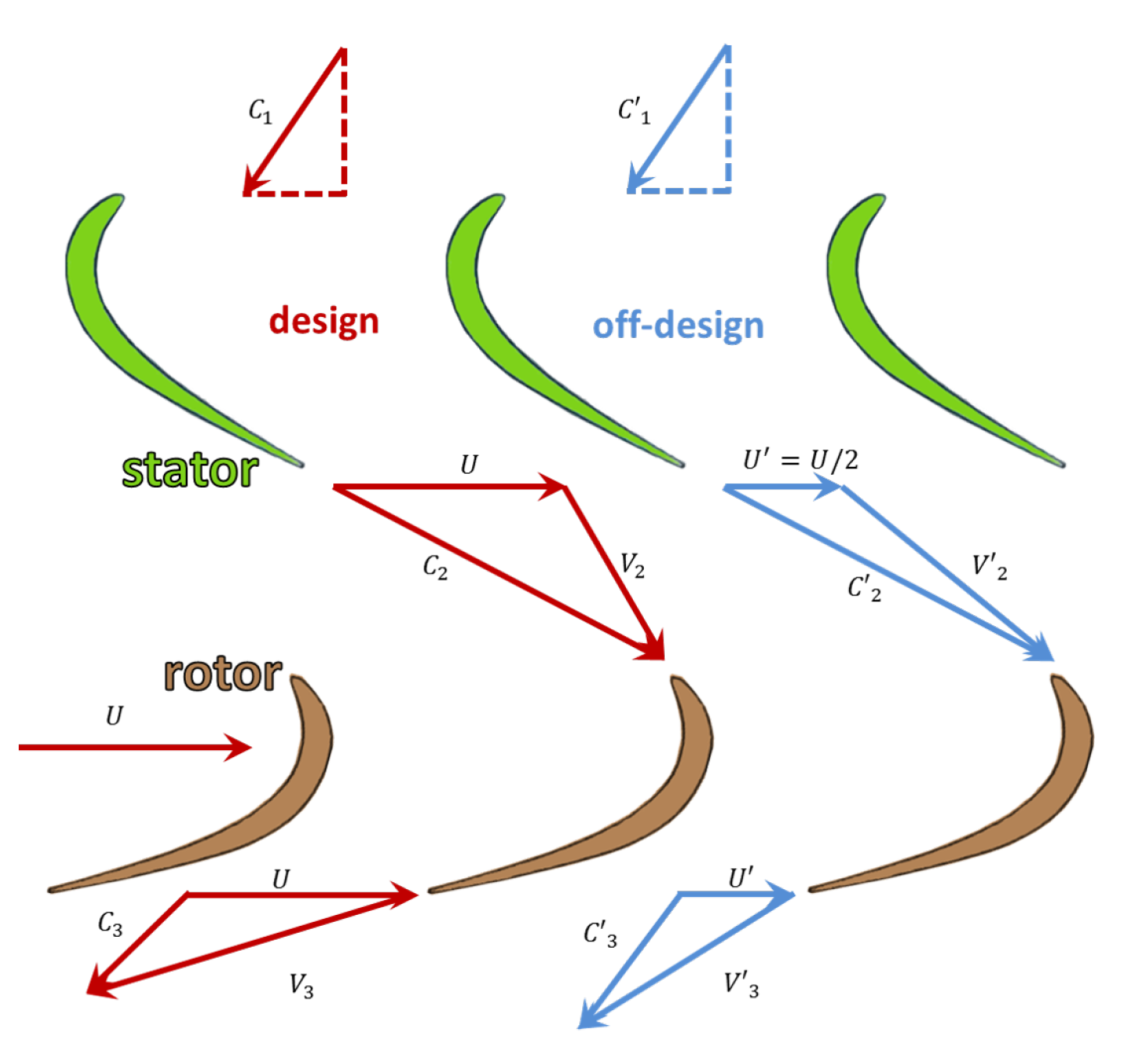
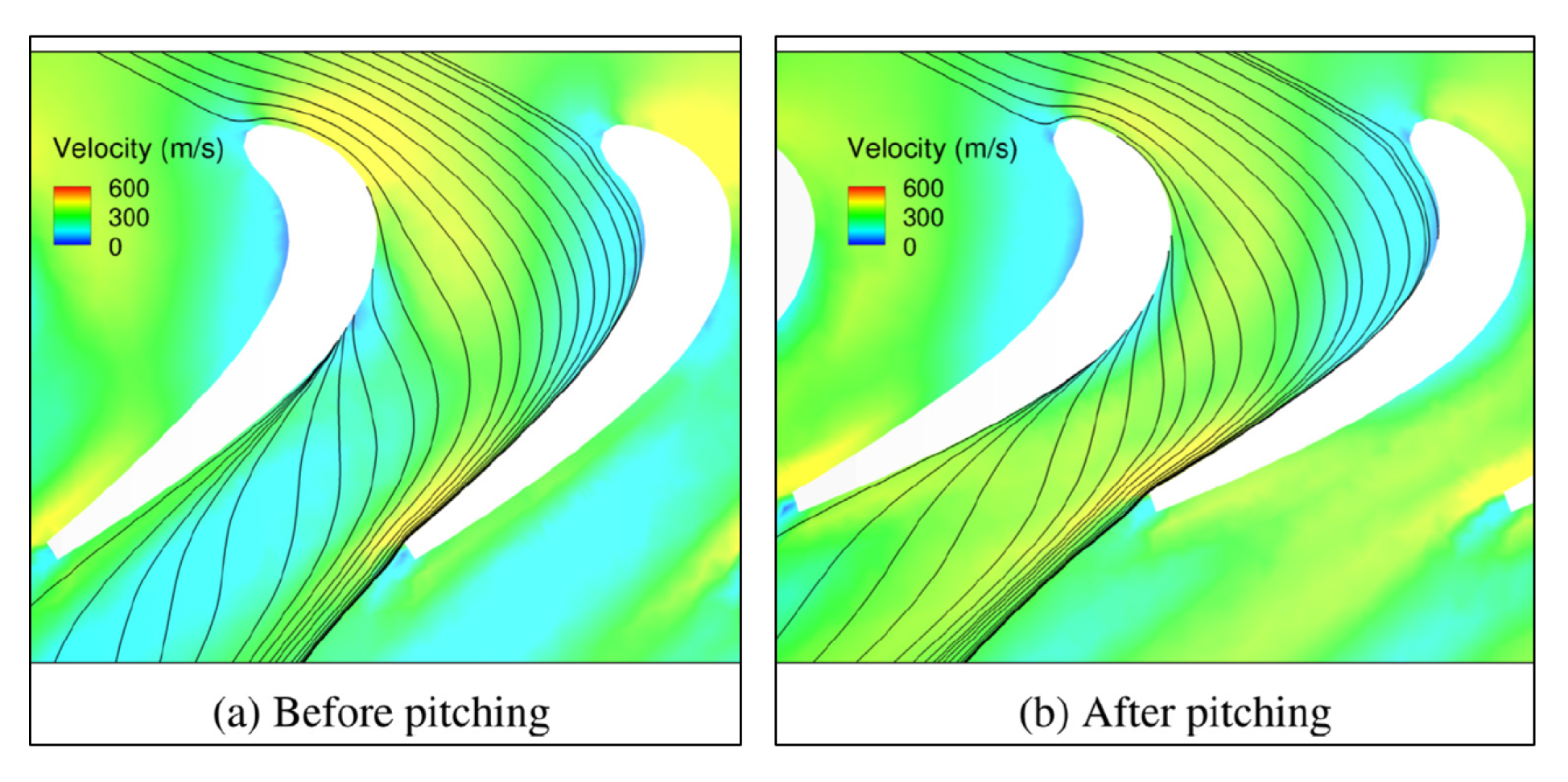
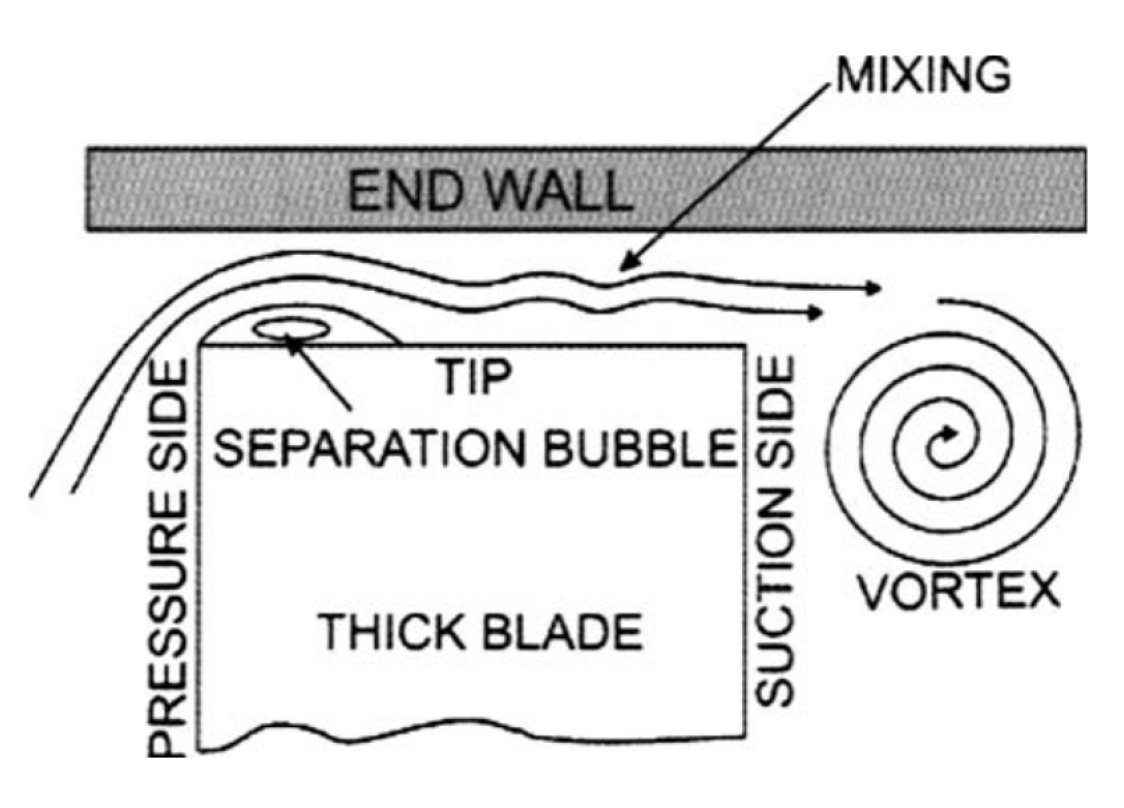
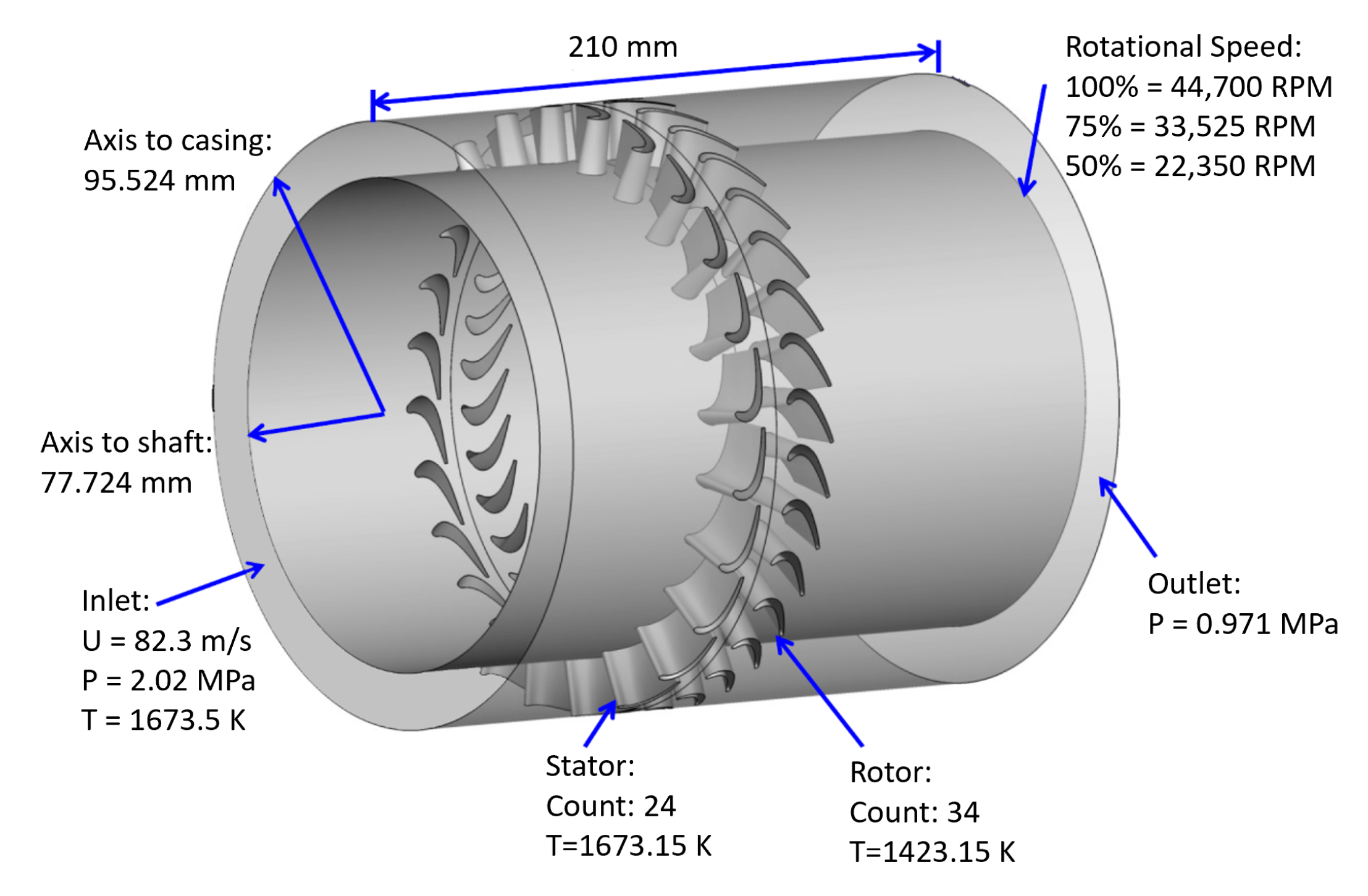

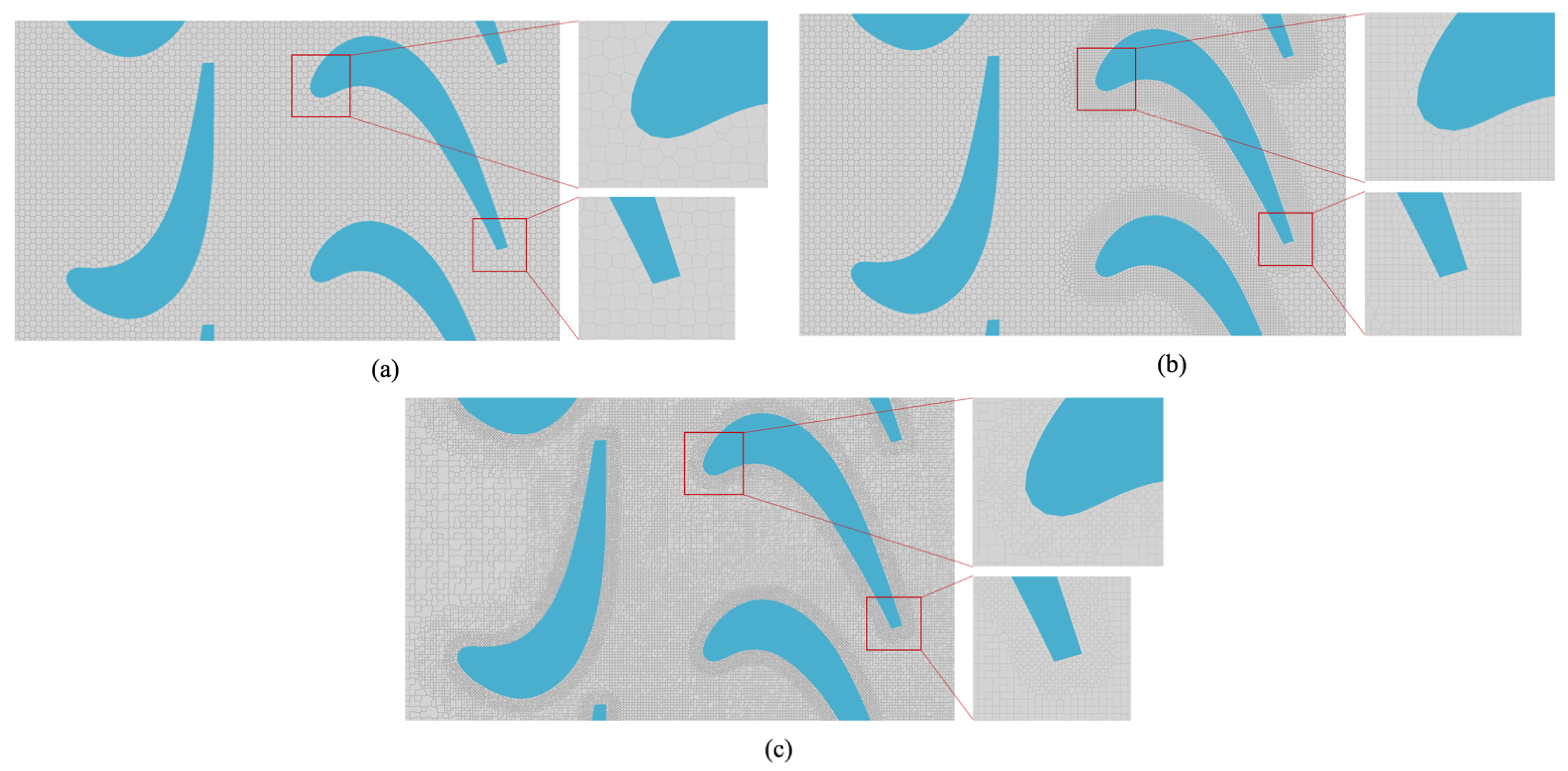
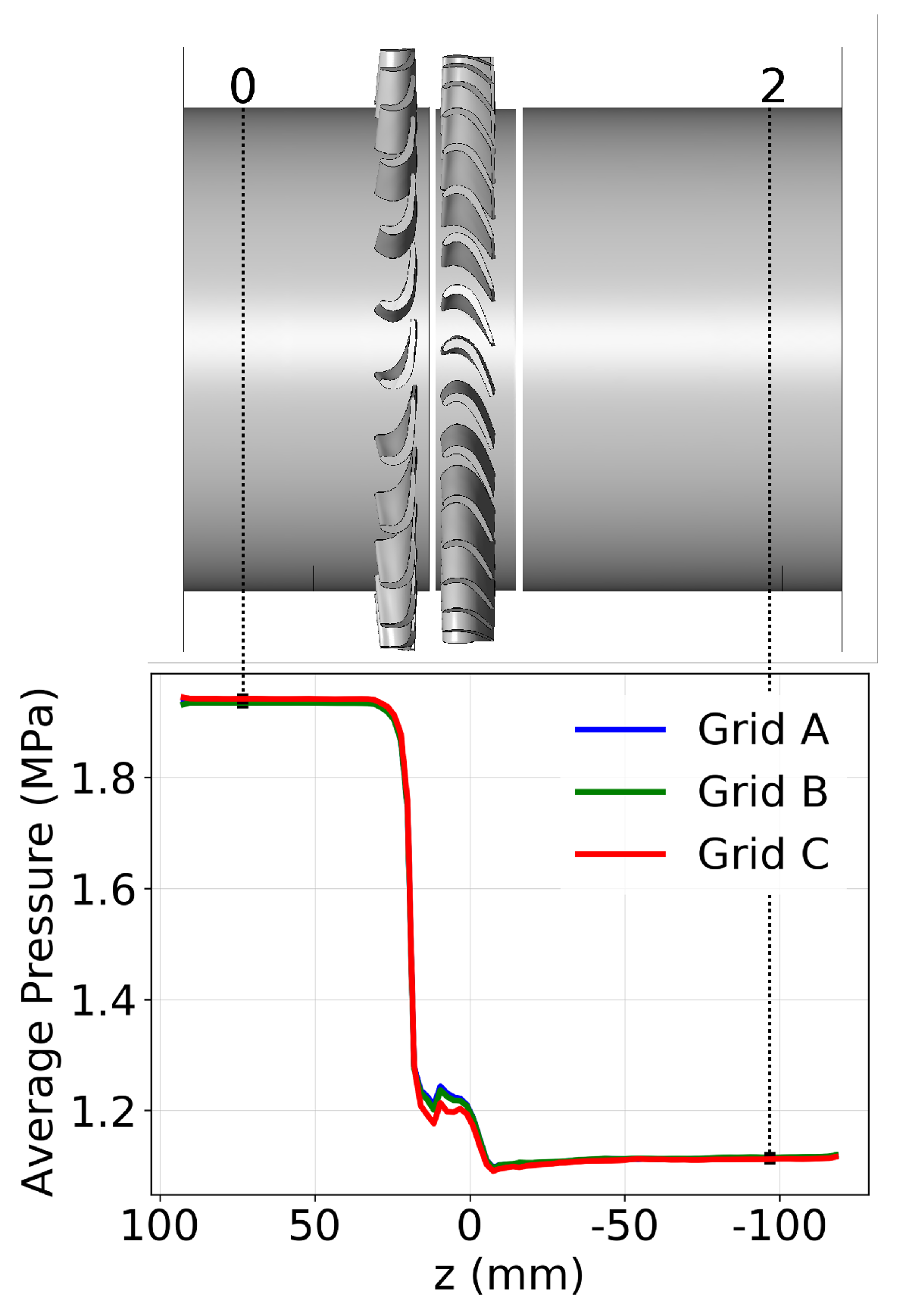

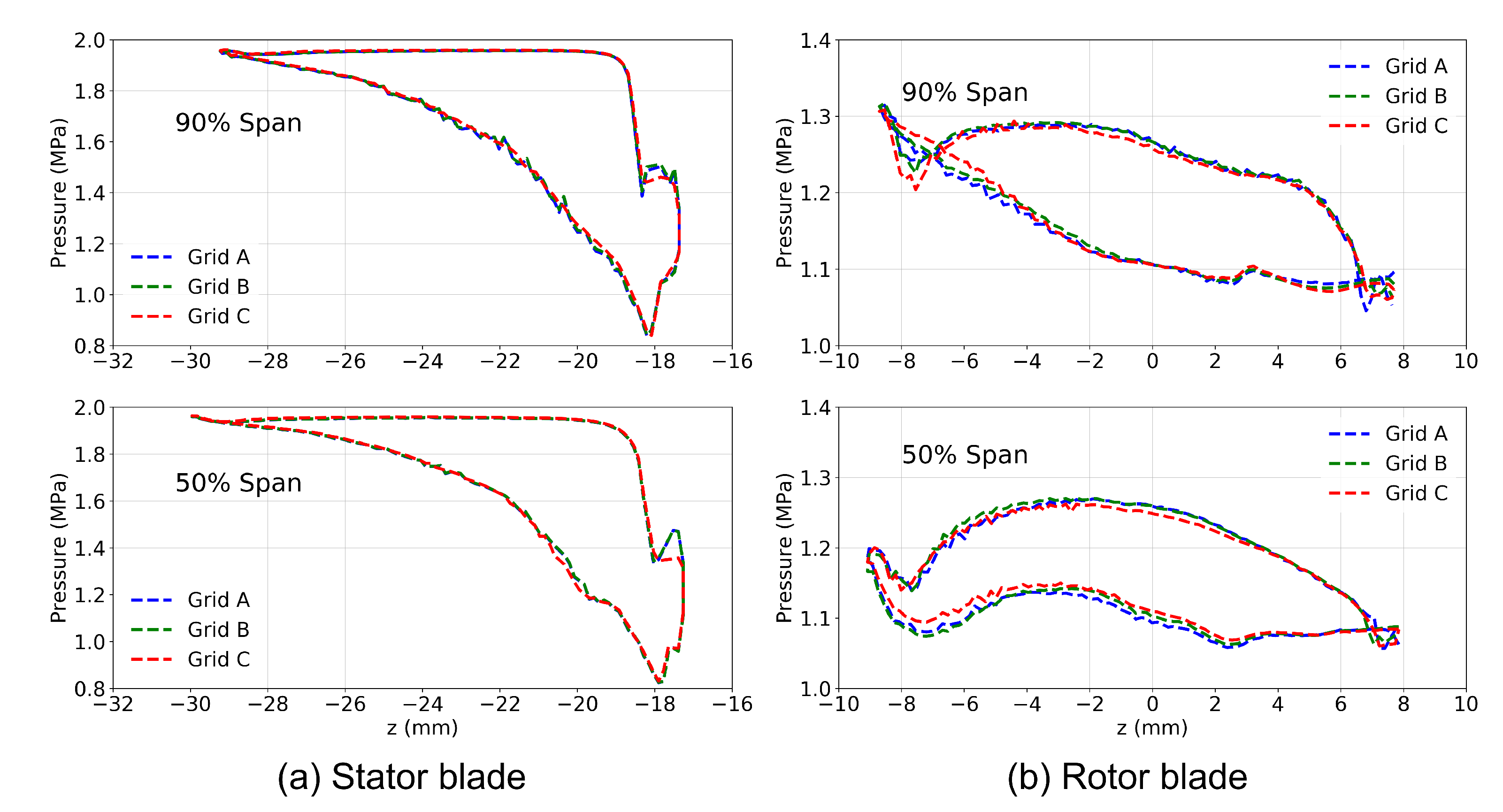


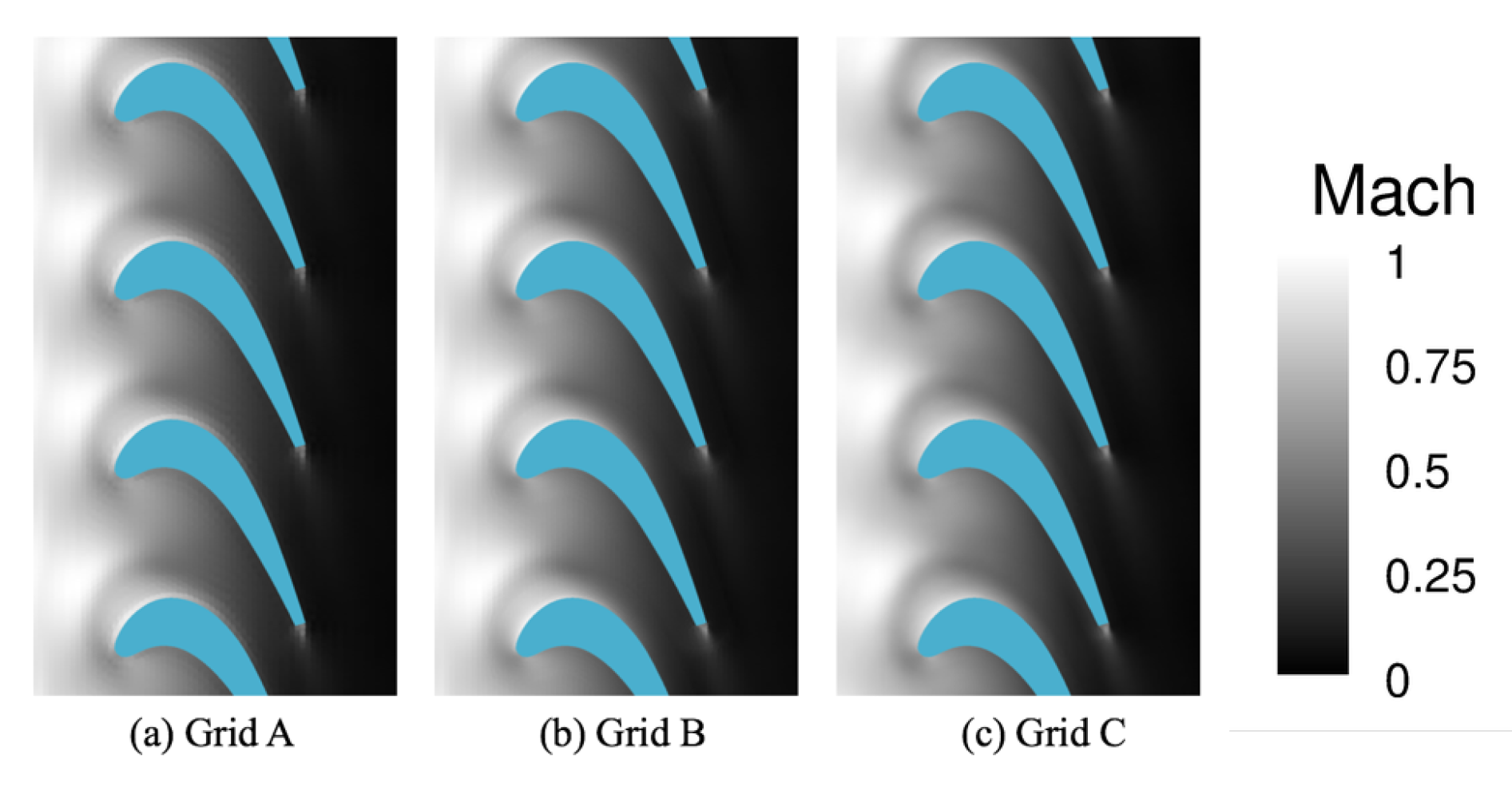
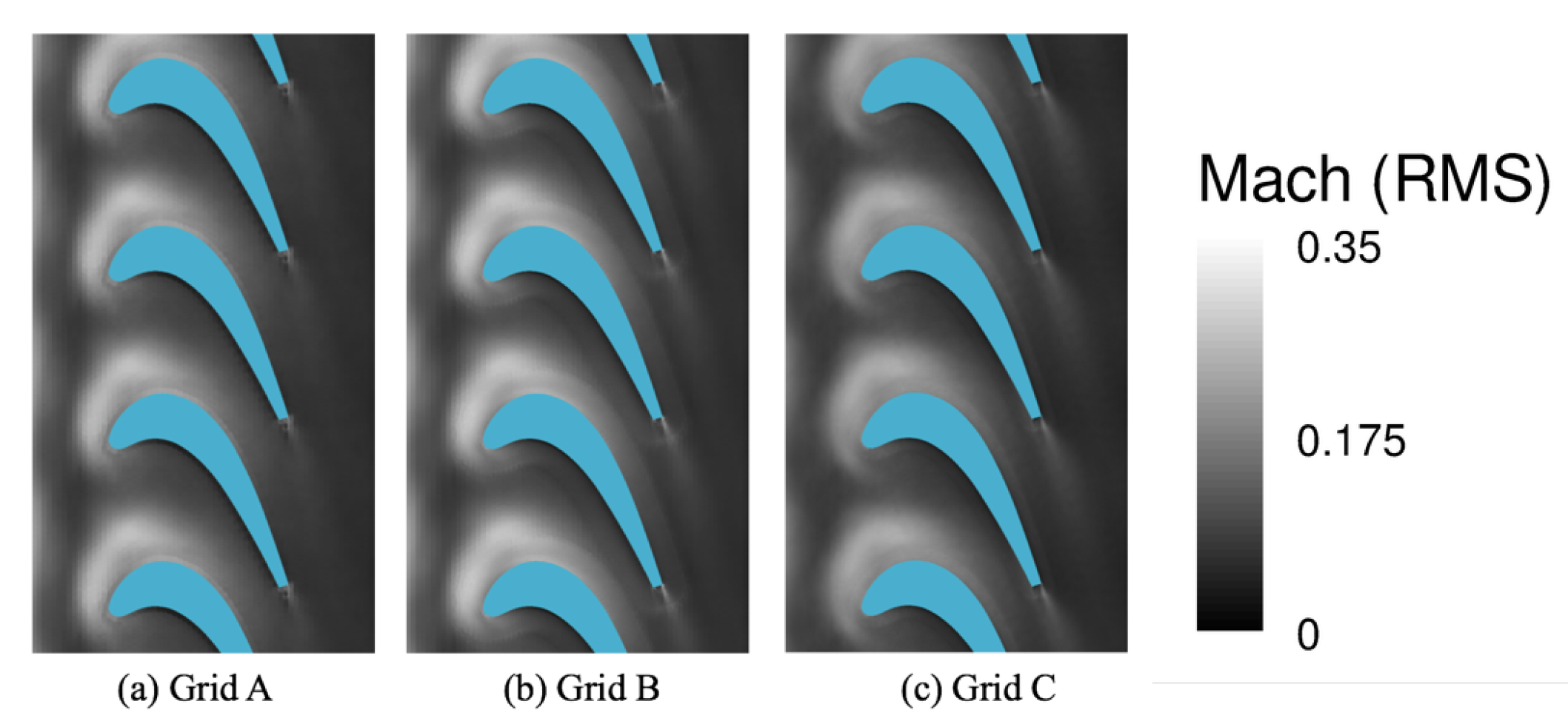
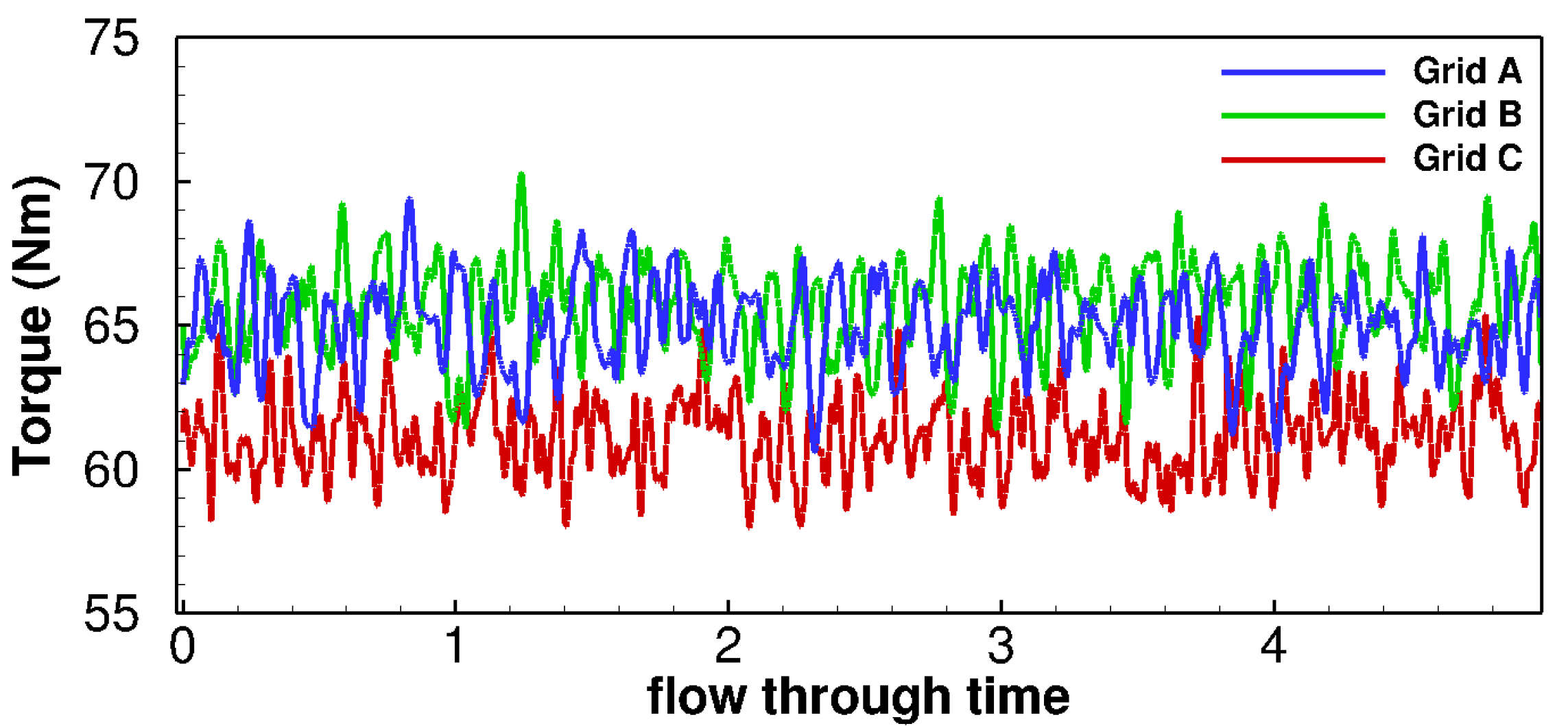
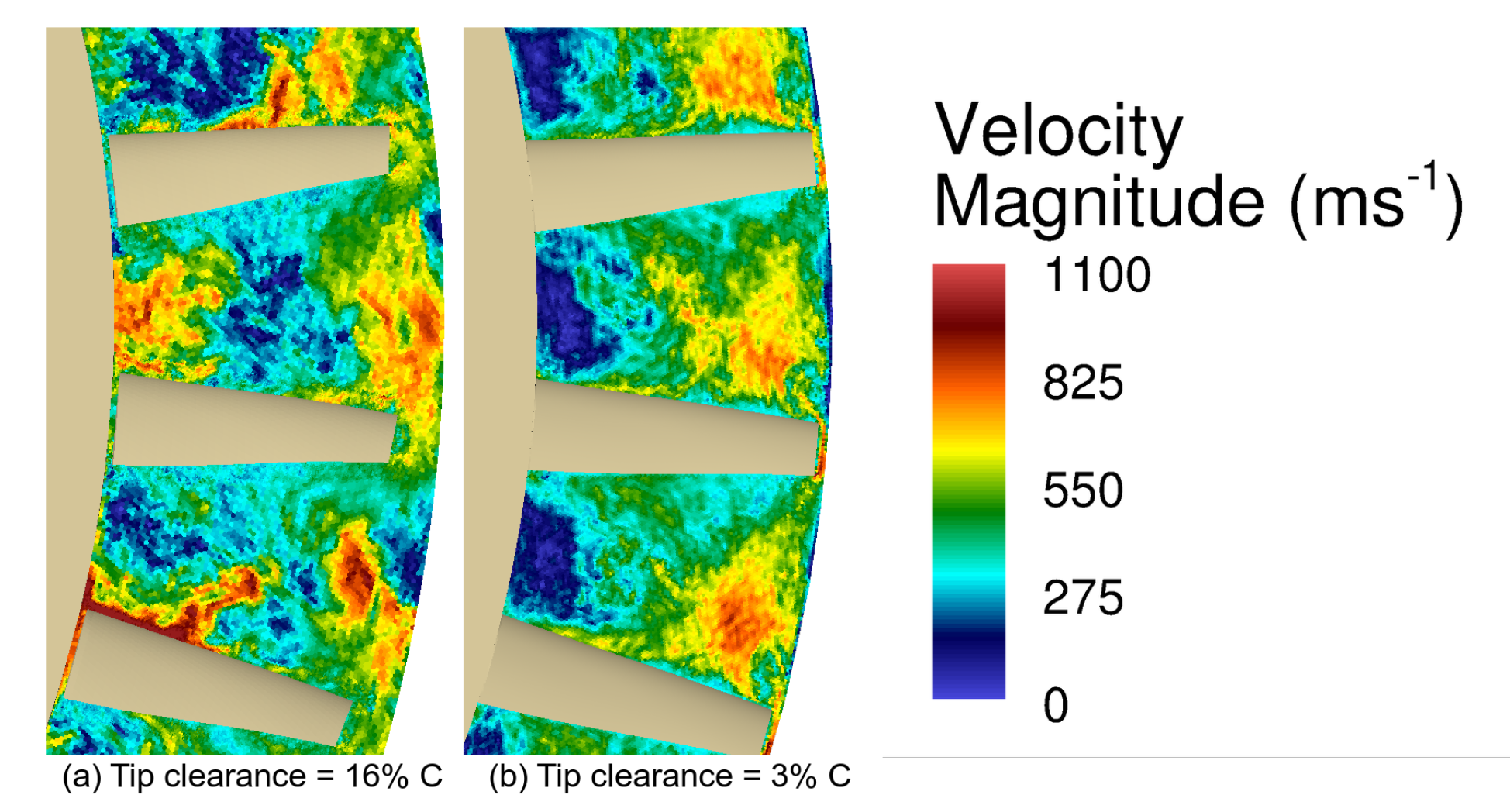
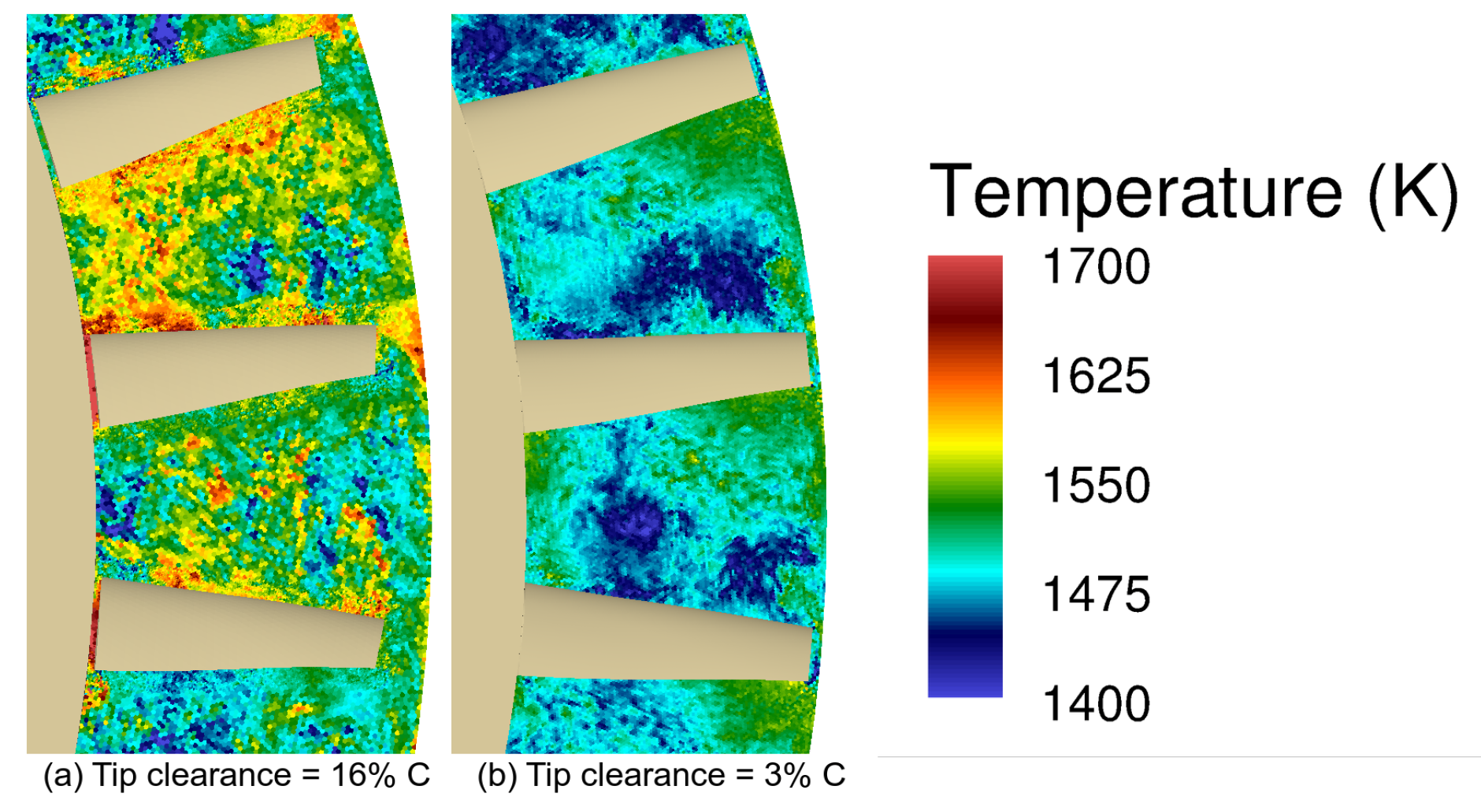
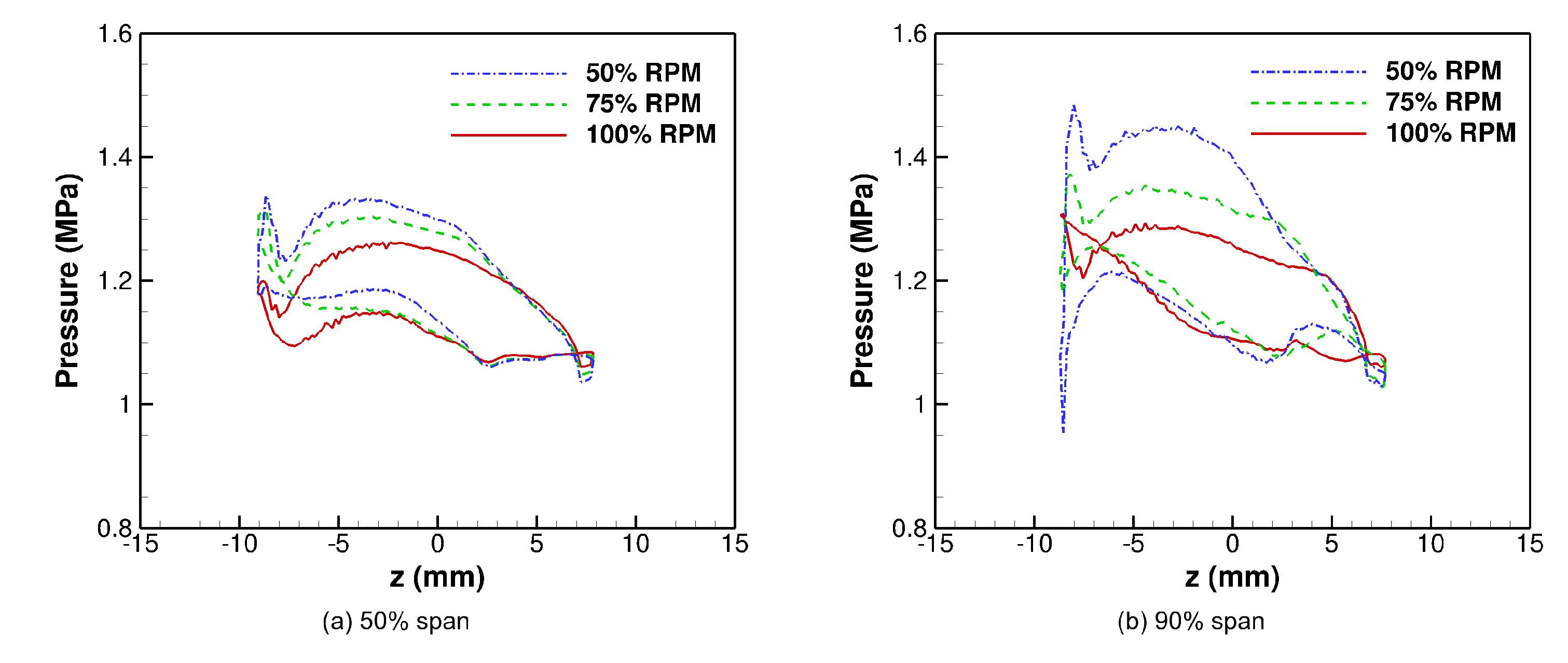
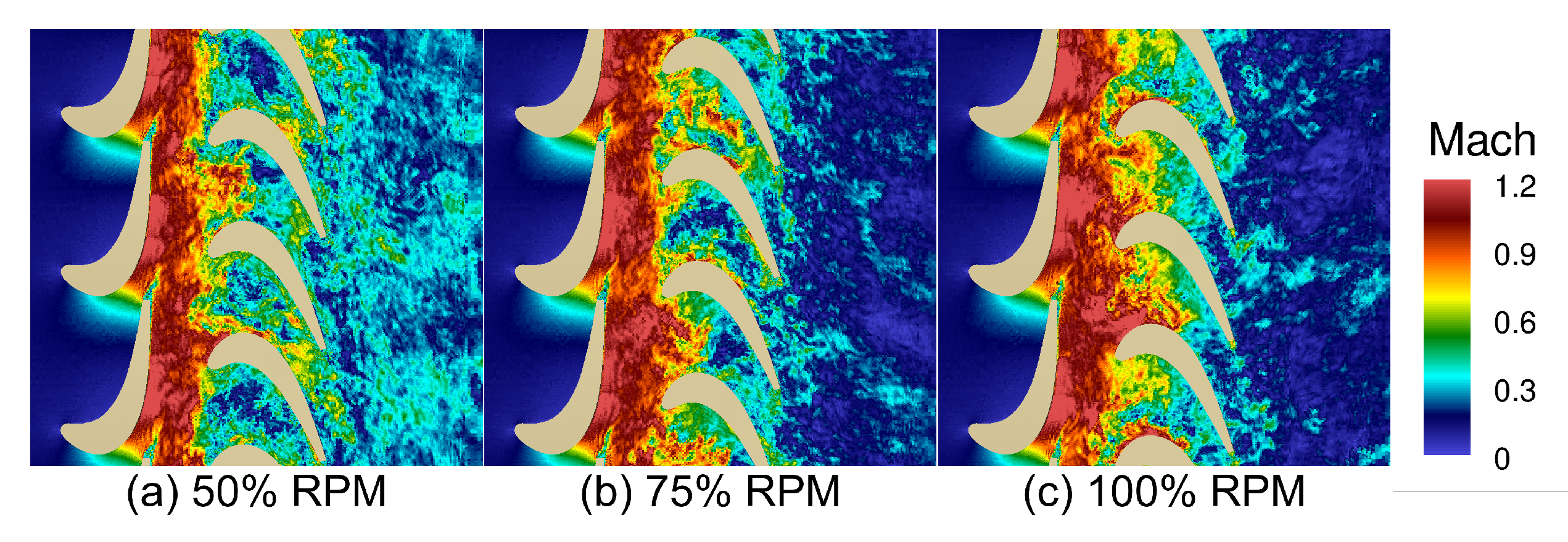
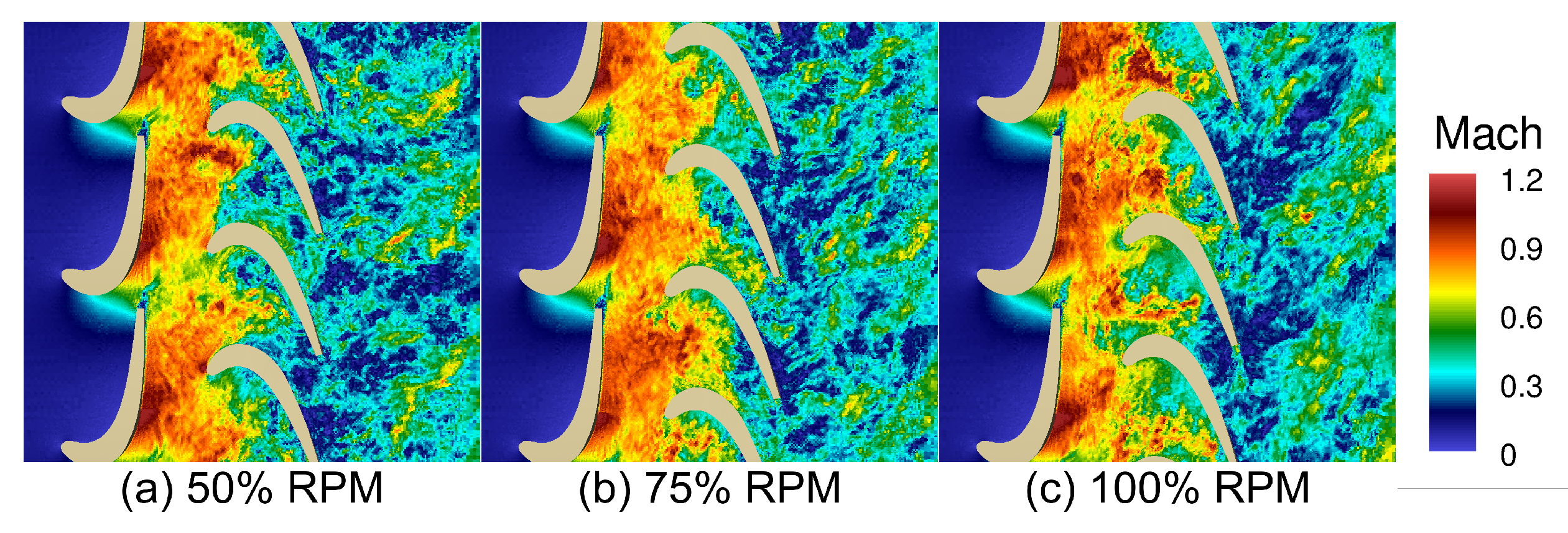


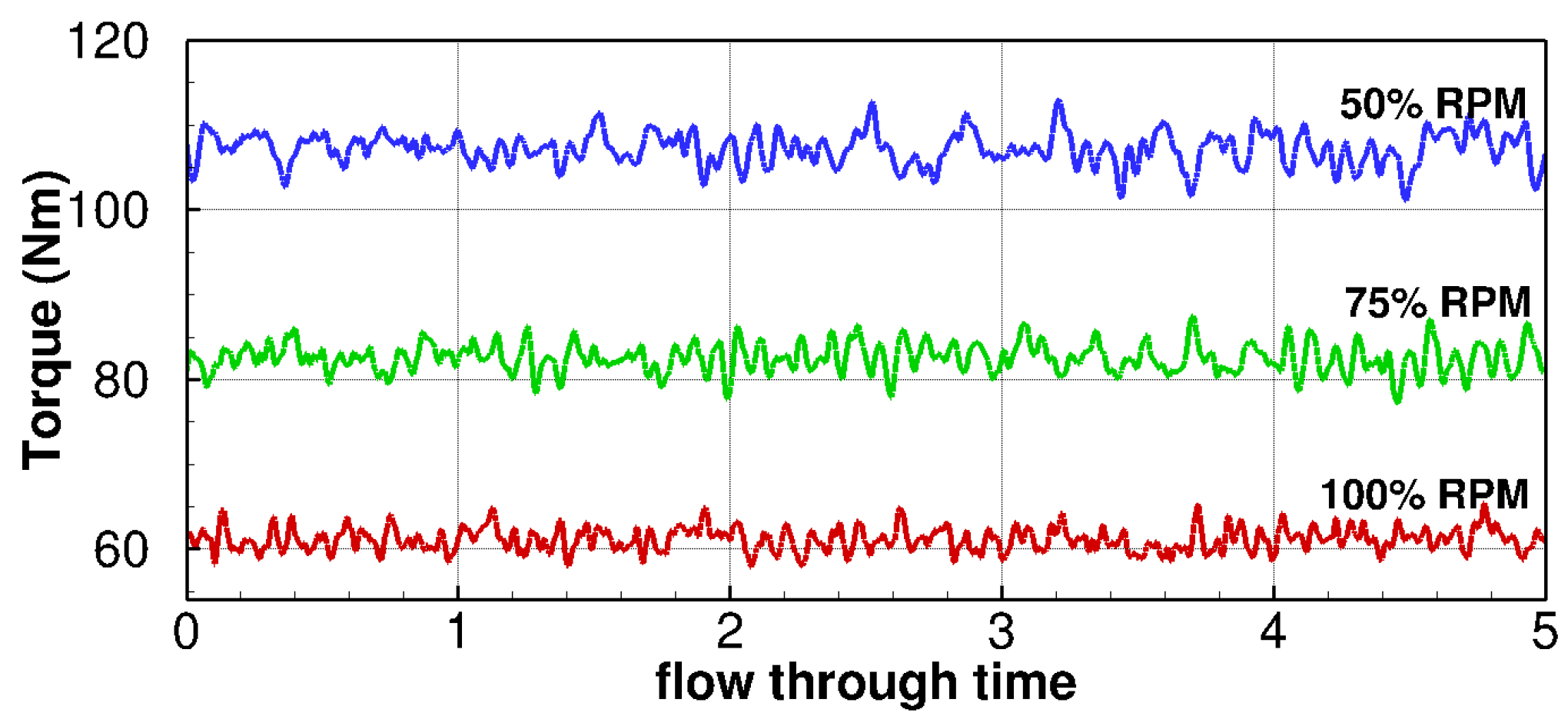
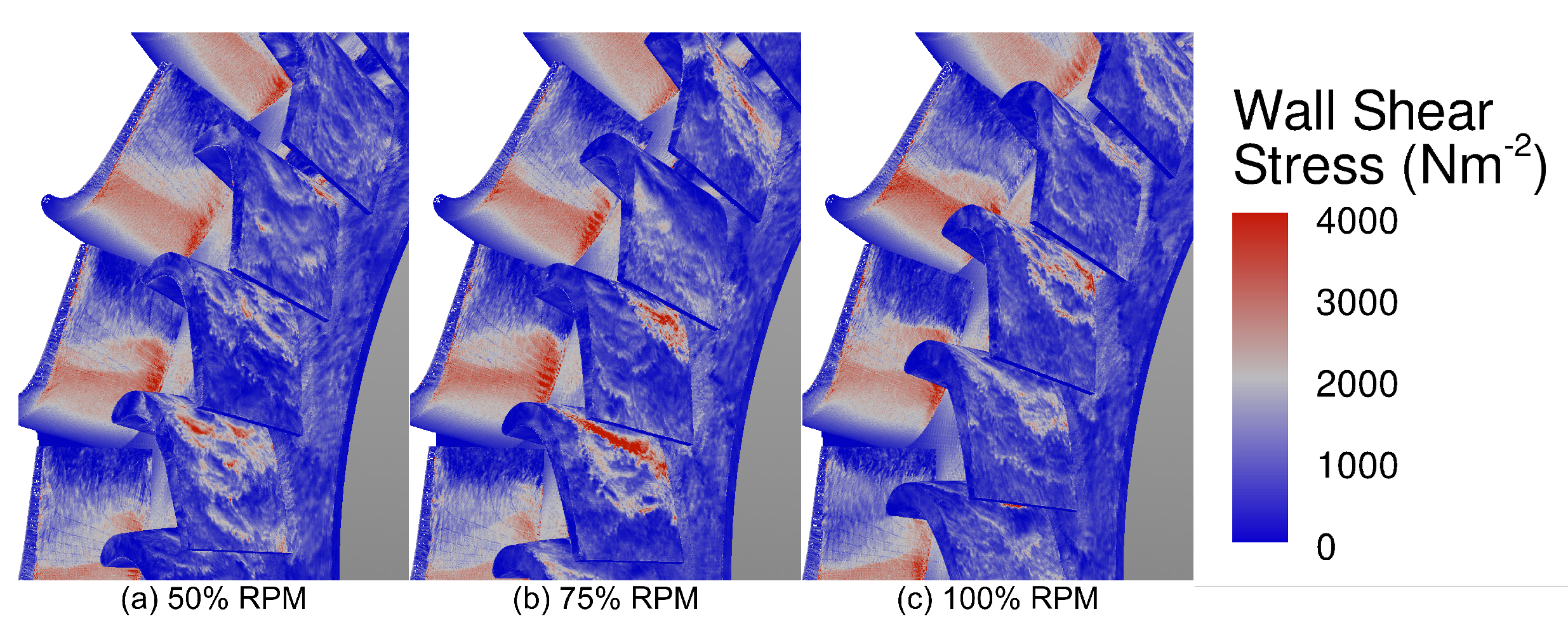
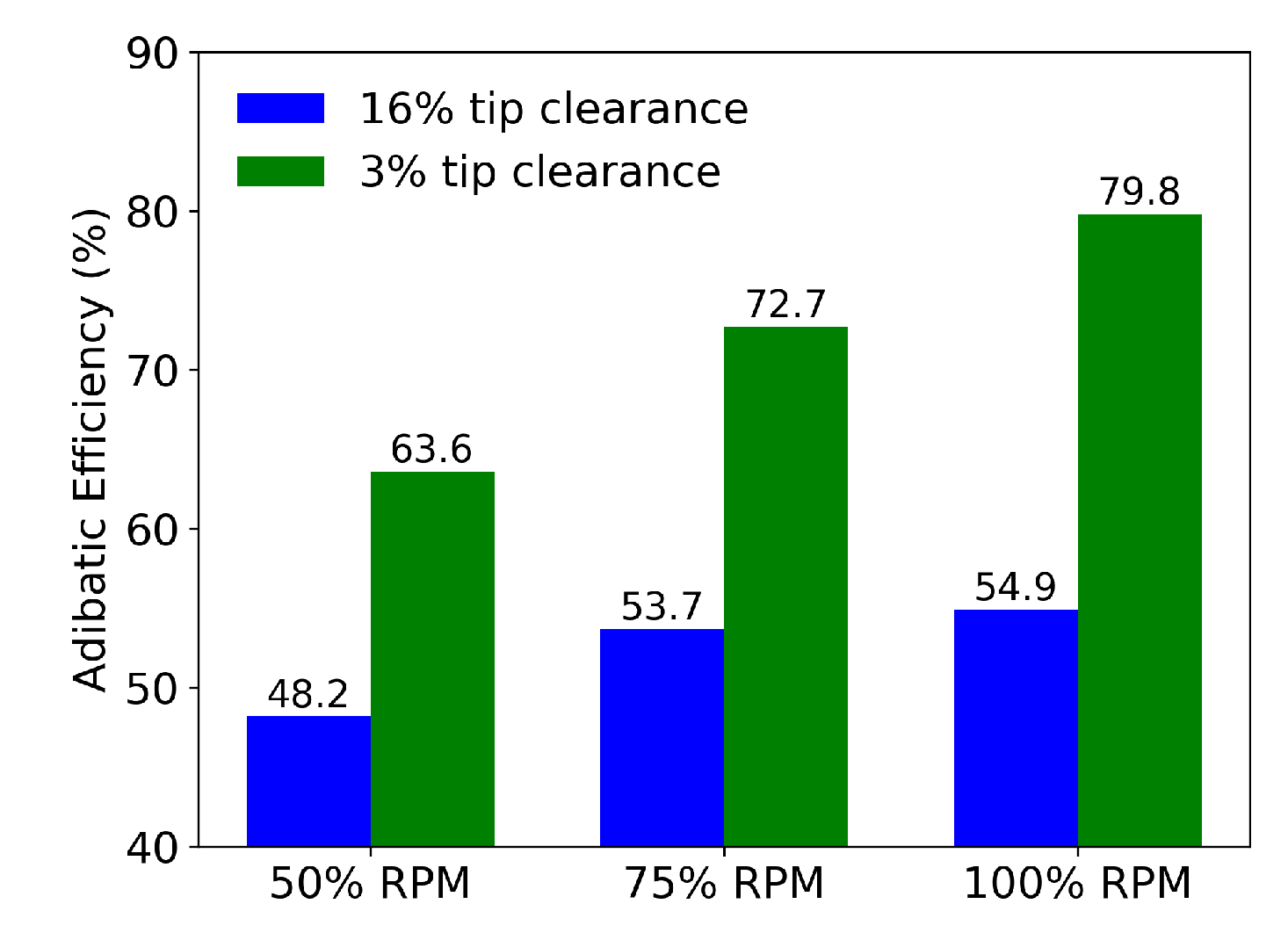
| Grid | Stator Vanes | Rotor Blades |
|---|---|---|
| A (7.97M) | 0.5500 mm, = 520 | 0.5500 mm, = 450 |
| B (13.5M) | 0.5500 mm, = 520 | 0.2750 mm, = 250 |
| C (79.3M) | 0.1375 mm, = 131 | 0.1375 mm, = 130 |
© 2020 by the authors. Licensee MDPI, Basel, Switzerland. This article is an open access article distributed under the terms and conditions of the Creative Commons Attribution (CC BY) license (http://creativecommons.org/licenses/by/4.0/).
Share and Cite
Jain, N.; Bravo, L.; Kim, D.; Murugan, M.; Ghoshal, A.; Ham, F.; Flatau, A. Massively Parallel Large Eddy Simulation of Rotating Turbomachinery for Variable Speed Gas Turbine Engine Operation. Energies 2020, 13, 703. https://doi.org/10.3390/en13030703
Jain N, Bravo L, Kim D, Murugan M, Ghoshal A, Ham F, Flatau A. Massively Parallel Large Eddy Simulation of Rotating Turbomachinery for Variable Speed Gas Turbine Engine Operation. Energies. 2020; 13(3):703. https://doi.org/10.3390/en13030703
Chicago/Turabian StyleJain, Nishan, Luis Bravo, Dokyun Kim, Muthuvel Murugan, Anindya Ghoshal, Frank Ham, and Alison Flatau. 2020. "Massively Parallel Large Eddy Simulation of Rotating Turbomachinery for Variable Speed Gas Turbine Engine Operation" Energies 13, no. 3: 703. https://doi.org/10.3390/en13030703
APA StyleJain, N., Bravo, L., Kim, D., Murugan, M., Ghoshal, A., Ham, F., & Flatau, A. (2020). Massively Parallel Large Eddy Simulation of Rotating Turbomachinery for Variable Speed Gas Turbine Engine Operation. Energies, 13(3), 703. https://doi.org/10.3390/en13030703





